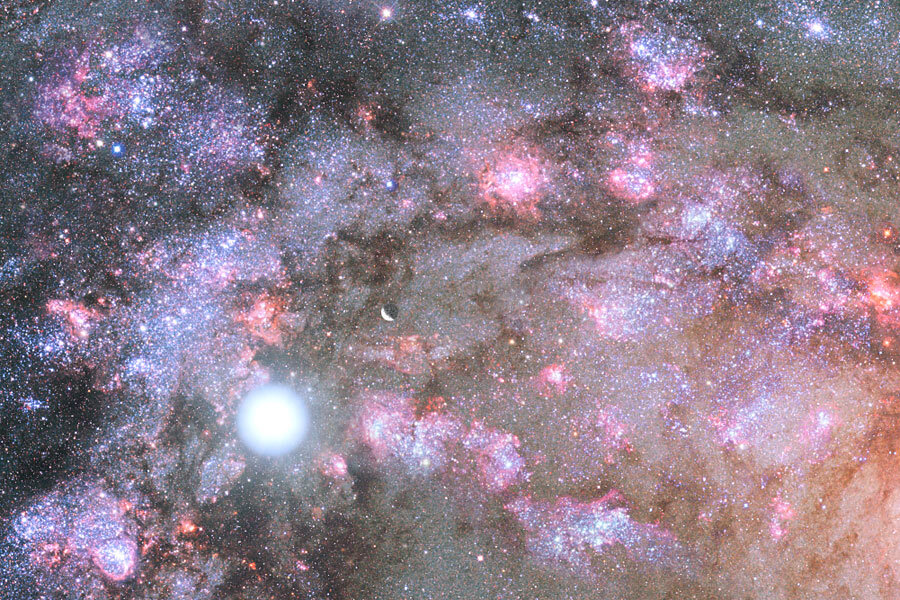'Sparky' and its new stars give clues to how massive galaxies evolve
Loading...
For the first time, a team of astronomers has spotted a galaxy actively building its dense central bulge, the foundation for the galaxy's continued growth.
The discovery fills a crucial gap in observations that are helping researchers build a cradle-to-grave sequence of the evolution of massive galaxies.
"We've seen a lot of the other stages and processes in action that are important for galaxy formation," says Erica Nelson, the lead author of a paper published Thursday in the journal Nature and reporting the find. "But we haven't seen this core-formation phase."
"It's really exciting to find one of these," she says. "We've been searching for so many years."
Even as a mere nucleus, this maturing galaxy, some 11 billion light-years away, is no slacker. Its mass in stars alone is 100 billion times the mass of the sun. The stellar mass of the entire Milky Way is about 60 billion solar masses, according to one recent estimate.
In essence, by roughly 3 billion years after the big bang, this nucleus had produced nearly twice as many stars as the Milky Way has during its 13 billion-plus-year history.
Moreover, the newfound galaxy is producing about 300 stars a year, compared with 10 stars a year forming in the Milky Way. This earned the object, formally known as GOODS-N-744, the nickname Sparky for its ferocious pace of star birth.
The discovery is the result of a dedicated attempt to catch galactic cores in the act of forming, says Ms. Nelson, a doctoral candidate in astronomy at Yale University in New Haven, Conn.
It's a daunting task. These objects are so distant that they are very faint from the outset. Such galaxies tend to be shrouded in dust and gas, drawing a veil across star-forming regions. The very expansion of the universe, as well as the shroud of dust, drives the faint light from the stars deep into near-infrared and infrared wavelengths, making them tough to detect from the ground.
In Sparky's case, the nucleus was missing a cosmos-crossing beacon common to galaxies at this early epoch undergoing a frenzy of star formation: intense radiation from the supermassive black hole presumed to be at its center. The copious amounts of dust and gas that form stars also feed the black hole.
The researchers suspect that the supermassive black hole was in a quiescent state, which turned out to be a boon for their observations. By catching the black hole nibbling rather than gorging, they could be sure that the spectral evidence they were gathering came from the stars and gas in the nucleus and not from the overpowering effect of emissions from the black hole.
A bit of serendipity was involved as well. The research team notes that since so few of these objects have been spotted at such distances, their shrouds of dust and gas must be thwarting detection. But Sparky apparently had a thin spot in its cloak oriented in just the right direction to allow the team to spot it.
"It's impressive work, and it's quite timely," says Jonathan Trump, a researcher who specializes in studying active galactic cores and galaxy evolution at Pennsylvania State University in University Park, Pa.
Dr. Trump and colleagues recently wrapped up observations of 13 compact star-forming galaxies at distances that give them ages of about 1 billion years older than Sparky. They appeared to be more highly evolved versions of Sparky, heading down a road that would lead to a shut-off in star formation.
The inactivity of the black hole at Sparky's center is intriguing, Trump says. Typically, when star formation increases in a galaxy like Sparky, so does the radiation emitted by its supermassive black hole.
Nelson and colleagues relied on data from the Chandra, Hubble, Herschel, and Spitzer Space Telescopes, as well from the ground-based Sloan Digital Sky Survey and the Keck Observatory in Hawaii.
Assuming that Sparky's star formation took place at a constant pace, the team estimated that its mass would have accumulated over a period of about 1 billion years. That is short compared with the age of the universe at that point, but it's too long compared with some theoretical predictions. The oddity implies that Sparky went through its fastest pace of star formation much earlier in its history or that it recently drew a fresh batch of intergalactic gas into its halo, a reservoir from which it drew to make more stars.
Encounters with intergalactic gas clouds would have more common back then, since the universe was far more compact, Nelson suggests.
As for Sparky's future?
"At some point, star formation will shut off," she says. "At that point it will be a very massive, very compact dead galaxy."
It will continue to grow, however, either through shorter, less intense spurts of star formation or by cannibalizing lower-mass galaxies that it encounters.
In the local universe, such galaxies have evolved to take the form of enormous elliptical galaxies "with very little ongoing star formation – big, red, and dead," she says.
The next step is to find more of these and study them – a task that NASA's James Webb Space Telescope, with its ability to see deep into infrared wavelengths, should make easier, assuming a successful launch and deployment. Launch currently is envisioned for October 2018.








